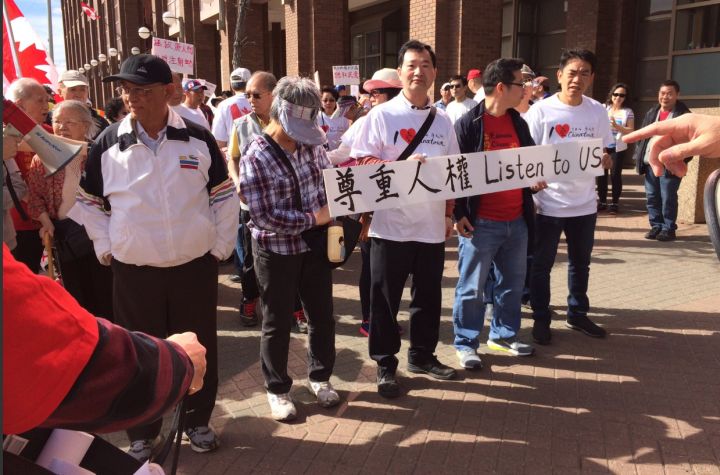Around 200 people marched through downtown Edmonton on Saturday to show their disapproval of city council’s decision to move forward with its plan for supervised injection sites.

On Tuesday, council voted 10 to one to write a letter of opinion to seek a federal exemption to bring the services to Edmonton.
The Chinese Benevolent Association said that decision left them “very upset.” The group organized Saturday’s protest, which saw people carrying signs with slogans such as “Listen to us,” “Save Chinatown” and “Keeping our kids safe.” Other signs read “Where are our rights,” “Why weren’t we informed” and “We deserve to be heard.”
READ MORE: Opponents of safe injection services near Edmonton’s Chinatown plan protest
The majority of the protesters were part of Edmonton’s Chinese community. The four sites being proposed in Edmonton would surround the city’s Chinatown – the Royal Alex, Boyle Street Community Services, the George Spady Society and Boyle McCauley Health Centre.
Michael Lee, chair of the benevolent association, said he is against the concentration of the sites as well as how the consultation was executed.
“People have not been informed or consulted about the proposal. We are not happy with the decision,” he said.
“A safe injection site in the inner core, where people are already stressed and disadvantaged, will only degrade the quality… of those facilities.”
Protesters wound their way from Canada Place, past the Chinatown gates to city hall.
“Part of it is, let’s be frank… you don’t want it to be in your backyard. No community should be bearing the full force of it,” Lee said.
Rachel Luo does not live in Chinatown but wanted to show her support by participating in the march.
“All the Chinese people, when they hear this, it’s sadness for sure. We wish all the communities know… we don’t want it to be damaged.”
Fellow protester Andy Chan said he feels Chinatown has been forgotten by the city.
“For every one step they take forward, it seems they’re taking two steps back. This whole revitalization of downtown… a wrench has been put into it,” he said.
“I just think we’re a nice scapegoat if anything.”
Chan admitted the idea of supervised injections is not a bad idea, but he still has reservations.
Ward 7 Coun. Tony Caterina was present and spoke at the rally. Caterina was the lone vote against the city writing a letter of opinion.
“The consultation process was extremely flawed and given the pressure that these three communities have been under… the concentration of the four sites in the same area really doesn’t make a lot of sense to me,” he said, adding he feels the city rushed the process.
Shelley Williams, chair of the group Access to Medically Supervised Injection Services (AMSIS), responded to Saturday’s protest by saying people deserve to be heard. But she stressed the sites will save lives.
“It’s proven to prevent other infections like HIV, hepatitis C as well as reduce public injecting. When these services have been developed in other communities, it has absolutely been proven that it hasn’t increased drug use in that particular community,” she said.
Williams also refuted the idea the consultation was flawed, saying discussions were held through doorknocking around the service locations, community sessions and meetings with community leagues.
- Buzz kill? Gen Z less interested in coffee than older Canadians, survey shows
- Naloxone-resistant street drug linked to 9 deaths in Eastern Canada seized in Alberta
- Bird flu risk to humans an ‘enormous concern,’ WHO says. Here’s what to know
- Canada updating sperm donor screening criteria for men who have sex with men
Caterina said he was concerned the sites could further stigmatize the inner city.
“The issue is the concentration of the sites in one area really goes against what we’re involved in discussing over the last couple of years. Concentrating anything is not necessarily the right thing to do,” he said.
Williams shot down the idea that the sites should be dispersed across the city.
The decision is ultimately up to the federal government while the provincial government would be responsible for funding the sites.


Comments